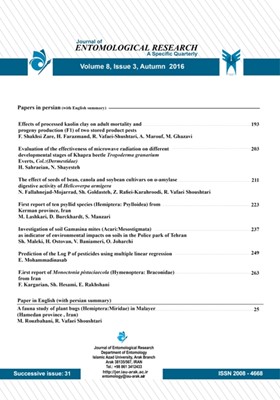The effect of seeds of bean, canola and soybean cultivars on α-amylase digestive activity of Helicoverpa armigera
Subject Areas : entomology and othea arthropodsN. Fallahnejad-Mojarrad 1 , Sh. Goldasteh 2 , Z. Rafiei-Karahroudi 3 , R. vafaie-Shoushtari 4
1 - Department of Entomology, Arak Branch, Islamic Azad University, Arak, Iran
2 - Department of Entomology, Arak Branch, Islamic Azad University, Arak, Iran
3 - Department of Entomology, Arak Branch, Islamic Azad University, Arak, Iran
4 - Department of Entomology, Arak Branch, Islamic Azad University, Arak, Iran
Keywords:
Abstract :
Digestive amylolytic activities in the midgut of 3rd, 4th and 5th instar larvae of Helicoverpa armigera (Hübner) on different host plants including white kidney bean (cultivars Daneshkadeh and Pak), red kidney bean (cultivars Akhtar and Naz), canola (cultivars Okapi, Opera, Sarigol and Zarfam), soybean (cultivars Clark, M7, Sari and Williams) and cowpea (cultivar Mashhad) were investigated under laboratory conditions. The amylolytic activity in 3rd, 4th and 5th instar larvae of H. armigera on different host plants in a broad pH range (pH 2–10) were studied. The results showed that the larva fed on canola cultivar Okapi had the lowest amylase activity on 3rd (0.42±0.005 OD/min), 4th (0.39±0.001 OD/min) and 5th (0.36±0.005 OD/min) instar larva. The highest enzyme activity was in 5th instar larvae of H. armigera on most plant cultivars (white kidney bean cultivars Daneshkadeh, red kidney bean cultivar Naz, canola cultivars Sarigol and Zarfam, soybean cultivars M7 and Williams). The amylolytic activity in 3rd, 4th and 5th instar larva of H. armigera was observed at pH 2.00 to 10.00. But the optimum p Hof amylase activity in the midgut of H. armigera larva was at pH 8.00 to 10.00. The maximum amylase amount in 3rd, 4th and 5th instar larva of H. armigera was observed on cowpea cultivar Mashhad at pH10.00 (1.34, 1.73 and 1.85 U/mg, respectively). Our findings provide useful information and when this information is used in association with other ecological and biological data, it may be valuable in development and implementation of management programs of H. armigera.
_||_


